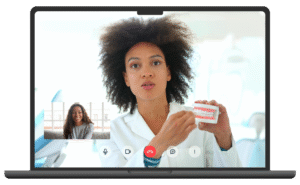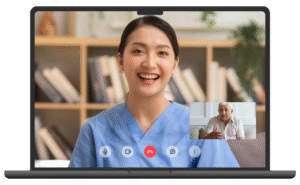
How virtual dentistry rewrites access and outcomes
“If you have a phone, you can now take that first step toward understanding your dental needs.”
— Brant Herman, CEO and Founder, MouthWatch and Dentistry.One
When a camera became a catalyst
 When a patient saw behind her own lower teeth in images taken on a dental camera for the first time, Brant Herman, CEO and Founder of MouthWatch and Dentistry.One, realized visibility changes behavior. That realization guided MouthWatch to become a trusted partner for more than 46,000 dental practices, with their cameras helping patients see and better understand their oral health. Now, Herman is extending that same principle through Dentistry.One: a pathway that begins with a smartphone and ends with coordinated, accessible, in-person care.
When a patient saw behind her own lower teeth in images taken on a dental camera for the first time, Brant Herman, CEO and Founder of MouthWatch and Dentistry.One, realized visibility changes behavior. That realization guided MouthWatch to become a trusted partner for more than 46,000 dental practices, with their cameras helping patients see and better understand their oral health. Now, Herman is extending that same principle through Dentistry.One: a pathway that begins with a smartphone and ends with coordinated, accessible, in-person care.
Dental disease is largely preventable, yet barriers, dental deserts, long waits, transportation, fear, and a shortage of Medicaid-accepting dentists keep millions from care. The model developed by the Dentistry.One team begins with low-friction entry points: a QR code in a clinic, a link from a Medicaid plan, or a tablet in a school nurse’s office, all of which lead to an AI-guided “SmileScan™.” Five guided photos produce an instant risk signal, inviting the patient into a virtual consultation. As Sharity Ludwig, Senior Director of Clinical Operations, puts it, “ SmileScan™ is a free starting point that warms people up to follow-up care.”
Virtual care meets dentistry
 In an era where telehealth has become part of routine care, virtual dentistry is the dental sector’s natural next step, a digital front door that meets people where they are and guides them into the full care continuum.
In an era where telehealth has become part of routine care, virtual dentistry is the dental sector’s natural next step, a digital front door that meets people where they are and guides them into the full care continuum.
Virtual dentistry is not an isolated innovation; it’s part of a broader shift toward connected, patient-centered care. Just as primary care utilizes telemedicine, remote monitoring, and care coordination to manage chronic diseases, Dentistry.One is employing live and asynchronous consultations, its AI-guided SmileScan™, and care coordination to triage, treat, and prevent oral diseases at scale.
Technology plus choreography
But technology alone isn’t the answer. What sets Dentistry.One’s approach apart is its choreography. Licensed clinicians triage patients asynchronously or in real time; oral health care advisors prepare families for what comes next, schedule follow-up visits, and verify insurance. “We don’t just tell someone to find a dentist,” Danielle Nuss, Patient Relations Manager, explained, “we secure the appointment and guide them every step of the way through it.”
The impact is concrete. Virtual triage diverts unnecessary emergency-room visits that deliver only temporary relief, not definitive care. It accelerates time to treatment for urgent needs and reduces total system costs. For clinics, receiving a digitally triaged patient means the evaluation is completed before arrival, including photos, a risk assessment, and a recommended care plan. Practices can schedule straight for treatment, improving throughput and reducing no-shows.
Scaling beyond clinic walls
For safety-net providers and DSOs, the effect multiplies. Constrained staff become more efficient, and provider time stretches further. “A single practice might move twenty additional patients a month,” Jamie Collins, Director of Sales and Virtual Care Solutions, noted. “But a coordinated Medicaid partnership or mobile clinic can touch dozens a day, getting people the care they need.” This scale matters where access is most limited across the US.
For FQHCs and community health centers, Dentistry.One extends the reach of care beyond the walls of the clinic. These trusted providers serve as patient hubs, identifying unmet oral health needs and connecting individuals to Dentistry.One for virtual screenings, consultations, and coordinated follow-up. Each referral kit includes clear staff instructions, table tents, and rack cards with QR codes that make it easy for patients to access Dentistry.One directly. By linking virtual care with on-the-ground community health, we’re creating a connected system that helps FQHCs do more with limited resources while improving oral and overall health outcomes across the populations they serve.
Operational trade-offs remain. Providers worry about revenue displacement and billing headaches. The Dentistry.One team reports that virtual problem-focused evaluations typically bill appropriate codes and, crucially, that triage commonly leads to higher-value in-office procedures, aligning incentives rather than cannibalizing care. As Nuss summarized, “Probably 90% of patients calling for dental emergencies can be diverted or guided to appropriate care.”
The real-world payoff
 Dentistry.One’s approach maintains the human element. Patients follow through because someone is waiting on the other side of the screen. A clinician who can act, a care advisor who books the visit, and coaches the patient to set expectations.
Dentistry.One’s approach maintains the human element. Patients follow through because someone is waiting on the other side of the screen. A clinician who can act, a care advisor who books the visit, and coaches the patient to set expectations.
“Success looks like a parent scanning a code at a pediatric visit and, within forty-eight hours, receiving a virtual consult, a care plan, and a scheduled appointment for their child,” said Herman. “All supported by a patient coordinator who explains sedation options, insurance coverage, and what to expect in the chair.” It looks like rural mobile clinics that fill their days efficiently using digital intake. It looks like fewer ER trips, more completed treatment plans, and a system that treats oral health as part of whole-person care.
Dentistry.One is using teledentistry and technology — not to replace dentists, but to make the dental system work for everyone. Through AI-powered screenings, virtual consultations, and guided care coordination, we’re making oral health more reachable, navigable, and sustainable for those who’ve been left out for too long. It’s a smarter, more accessible path to better health.
Dentistry.One in action (case study)
Mainely Connections, a Dentistry.One partner that runs mobile dental vans and school programs across Maine, uses the platform to make intake truly holistic. Clinicians collect social needs data during intake (including housing and food security) and integrate dental screening into that workflow. Eden Ivie, Director of Client Success, described a pilot where intake included photos taken by medical staff, which were routed to the mobile team to prioritize and coordinate in-school care. “When they do intake, it’s not just when was your last dental visit… it is very holistic care,” she said.
Why it matters: mobile clinics already have trusting community relationships; digital triage helps them focus scarce clinical visits on patients who need on-site treatment that day.



